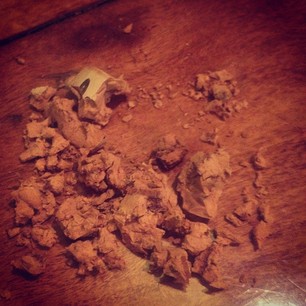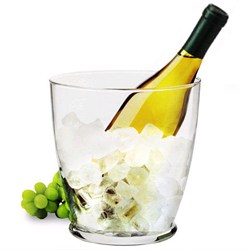Opening a bottle of wine changes its taste dramatically over a few hours and accelerates in next day or two exponentially. This is due to massively more air that the wine comes in contact with after opening as compared to the very little it has experienced while sealed and laid down in the cellar.
During the time in the bottle, only about 5 – 10 ml of air space exists in a 750 ml bottle of wine for the wine to mature by interacting with the air. With cork, a few more ml seeps through each year (through evaporation of wine) to continue to help the wine mature. If there is a cork problem, though, and a lot of air is leaking into the bottle, the wine will mature far too quickly and not be drinkable. For this same reason, once opened and exposed to much more air, the bottle will become undrinkable after a few days.
Unless you are going to drink the entire bottle over several hours, you need to concern yourself with preventing as much air as possible from interacting with the wine to decelerate the ruin of the wine. There are several ways of storing wine:
- Stick the original cork back in to stopper the wine bottle (keeps wine good for about 1 – to 1.5 days)
- Use a simple consumer manual rubber stopper and vacuum pump set to extract excess air from the bottle (keeps wine good for 2 – 3 days)
- Use a commercial pump and storage 2-bottle set (keeps wine good for 4 – 6 days)
- Use a carbon dioxide, nitrogen, and argon gas replacement system that is completely closed sealed (keeps wine good for up to 2 – 3 weeks)
After decanting wine for the right period of time, it is important to get the wine back into a bottle and stopper it as soon as possible. While several minutes to several hours (in most cases) of decanting will improve the wine, anything after that will only help the wine deteriorate and turn into vinegar. To slow this process down to ensure you can finish the bottle of wine prior to it going off, you need to minimize its interaction with air to the least amount of time possible.
Every time you open the bottle again to pour another glass, you are letting new air into the bottle, and as the bottle of wine empties, the amount of new air introduced increases, which quickens the pace of deterioration. Therefore, it is important to stopper the bottle immediately again once you have finished pouring to minimize any excess air in the bottle. This is why vacuuming the air out and replacing it with a gaseous blend is the most effective way to keep wine fresh for several weeks.
If the cork is still intact or you still have the screw top after opening the bottle, you can use it to stopper the wine. While there is no expense to this method, the wine will worsen overnight and not be as drinkable the following day, or at least certainly not drinkable by the second day following opening. If the bottle has been left half empty overnight, you have introduced a lot of new air into the wine which will quickly deteriorate it. This approach can be used successfully for keeping a bottle of wine fresh for several hours or maybe from afternoon until evening, but I never would use it to store a half-empty bottle overnight. I use this approach when I have decanted a fine wine for several hours, then re-bottle it to bring to a restaurant within the next hour or so.
The most cost effective way to store wine and keep it drinkable for one or two more days is to use a vacuum pump and cork set. These tend to cost around $20 – $25 for a pump and a few stoppers and you can buy more stoppers if required. This uses a special artificial stopper with small holes and one-way openings. The pump is used to extract as much air as possible and create a vacuum in the bottle. This significantly reduces the amount of air in contact with the wine and slows the deterioration process, extending the life of the wine by another day or two.
I have a vacuum pump set and have found this to be great value. For only $20 – $25, you will save many quarter- to half-bottles of wine for another day and over time this can mean keeping thousands of dollars of wine drinkable. Since it is just my wife and I usually at home for dinner, we may not drink more than a half bottle or little more during any evening. We will usually have two or three bottles opened at a time, as our mood changes or as we have a snack or meal. Using the vacuum pump and stopper method keeps several bottles fresh and available to provide us with good choice.
Additionally, when we have larger dinner parties, we will have eight or ten bottles of wine we want to serve upon arrival, with each food course, and for after dinner. But you are never sure how many people are going to be drinking (one night a friend who we did not know was pregnant was not drinking, for example), and we may have already decanted several of the finer wines, so we might have three or four partial bottles left over at the end of the night. By using this vacuum pump, we can then keep and drink the partial bottles over the next few days.
The vacuum pump set is a great option for the money. However, the technology is more limited than with the next higher up commercial model. Sometimes the rubber stopper seal will be nudged (possibly even upon removal of the pump) and let air re-enter into the bottle. (You can tell if this has occurred when you open the bottle and there is no popping of the vacuum. If there is a definite vacuum breakage popping sound, then you know it was sealed properly.) If this occurs, you should make sure to drink the rest of the wine right away, or you risk it going bad over another day. If the seal has remained intact, you may be able to get another day of good drinking from the wine. Unfortunately, there is really nothing you can do to determine if the seal is intact or not until you open it again. I just try to be very careful to remove the pump from the stopper after pumping by lifting it straight up. But the seal also may break sometime during the night based on the opening of the bottle. Based on bottle type, there may be some small differences in the diameter of the bottle opening, causing the seal to be more fragile for wider bottle openings than for narrower ones. Additionally, if there is some residual wine liquid on the neck where the stopper has been inserted, then there may be some slippage and the seal could break.
The next day or day after, you will have noticed some changes in the taste of the wine. It is usually smoother (which can be a pleasant improvement if it was tight when you opened it), but you have usually lost some of the grape fullness of flavor. Therefore, the wine might taste slightly less robust. After a couple of days, it may even taste ‘dead’ or totally flat using the vacuum pump method of storage.
 The next higher up option for wine storage after opening the bottle comes in a small refrigerated unit that has two compartments to hold two different bottles. Each bottle has a pumping and extraction capability and for most models, each bottle can be stored at a standard white wine or red wine temperature. Each compartment is set separately you can either store two whites, or two reds, or one of each at the right temperature.
The next higher up option for wine storage after opening the bottle comes in a small refrigerated unit that has two compartments to hold two different bottles. Each bottle has a pumping and extraction capability and for most models, each bottle can be stored at a standard white wine or red wine temperature. Each compartment is set separately you can either store two whites, or two reds, or one of each at the right temperature.
The top of the line unit to store opened bottles costs several thousand dollars and can be configured to store as many bottles as you like. They typically come in a configuration to store four bottles, but can be customized to store less or more. Additionally, they can be provided as a counter top unit or designed to be built into the wall or cabinetry. Wine features such as this type of storage unit plus Vintec or other manufacturer’s cellar units are now being featured as key aspects of kitchen renovations. I love things that are very functional and very stylish and this type of system fits both characteristics!
These systems are manufactured as closed systems where a tight seal is provided for each bottle. They typically have temperature control to be able to adjust the temperature to be suitable for a certain type of wine (sparkling versus white versus red). They have much higher quality parts and are custom assembled to suit your needs. I am hopeful to get such a unit someday when I have the money and also know that I will be living in that house for a long, long time. They will allow a wine to be opened and drunk over several weeks. The reason they work so well is that they ensure air cannot creep into the space in the bottle as the air has been replaced with carbon dioxide, nitrogen and argon. By doing so, oxidation has been reduced drastically, preserving the quality of the wine longer.
There are a number of suitable options to keep your wine as fresh as you need it once you have opened the bottle. They come at different value points and vary based on how long you would typically need to keep bottles opened before finishing them. The important thing is to always stopper the bottle with one method or another as soon as you can and to extract as much air as you can from the bottle. This will slow the rate of deterioration and preserve your wine at a level enjoyable for drinking for a longer period of time.
Steve Shipley, author Wine Sense, out early 2014. Published by InkIT Publishing
© 2013. Steve Shipley
SAZ in the Cellar on Facebook
Wine Pinterest Boards
Twitter: Steve Shipley @shipleyaust; InkIT Publishing @inkitpub








